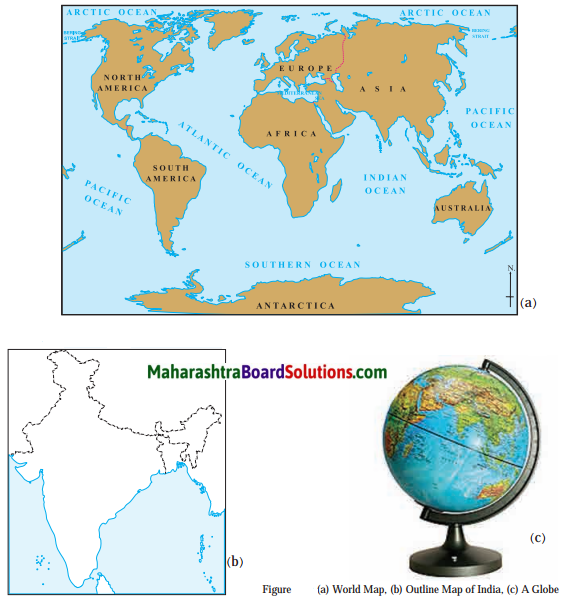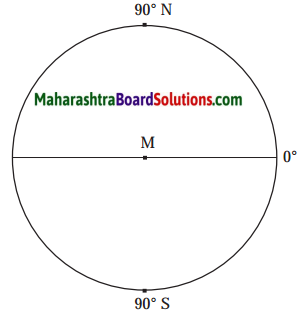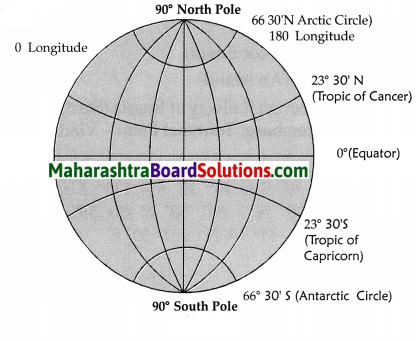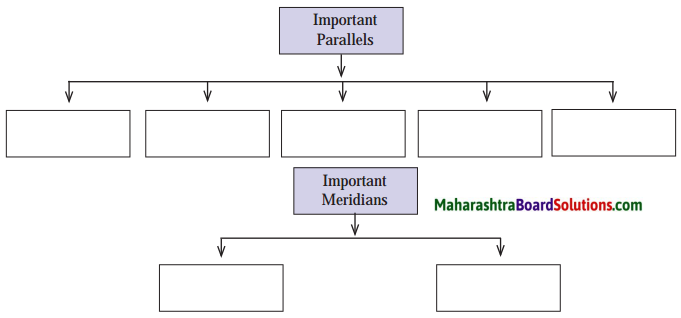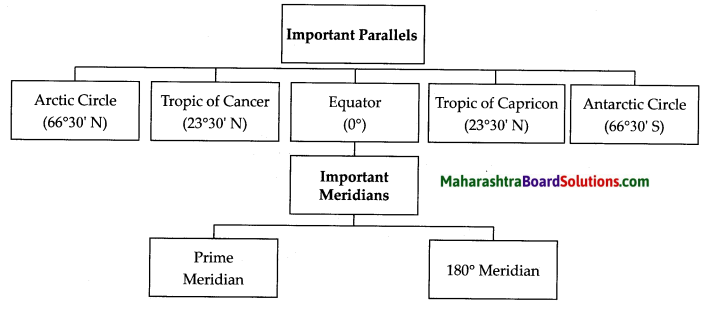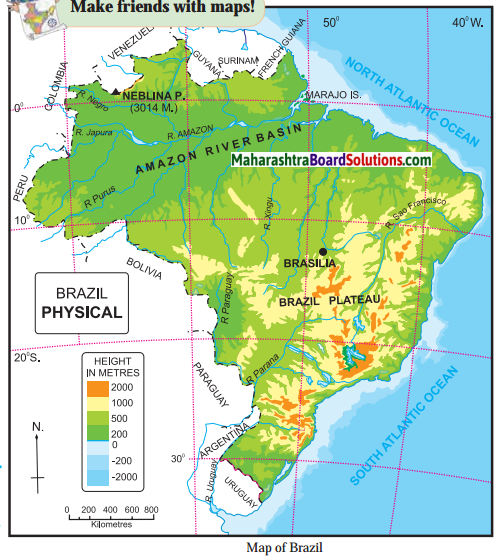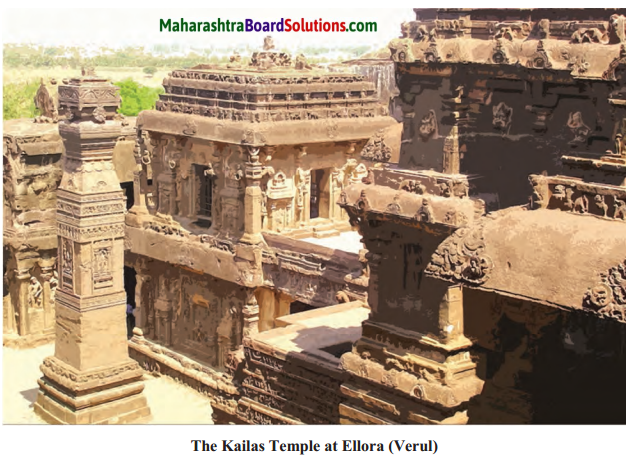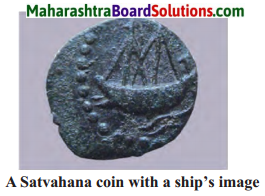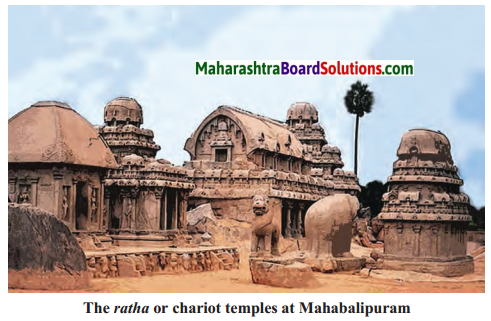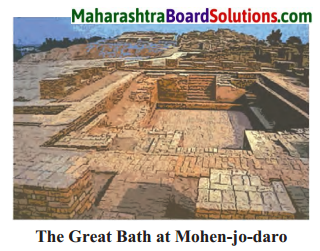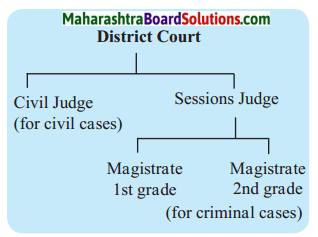Balbharti Maharashtra State Board Class 6 History Solutions Chapter 8 States after the Maurya Empire Notes, Textbook Exercise Important Questions and Answers.
Maharashtra Board Class 6 History Solutions Chapter 8 States after the Maurya Empire
Class 6 History Chapter 8 States after the Maurya Empire Textbook Questions and Answers
1. Can you tell ?
Question 1.
The kings who started the minting of gold coins in India.
Answer:
The Kushana kings
Question 2.
The city established by Kanishka in Kashmir.
Answer:
Kanishkapur
Question 3.
The king who played the veena.
Answer:
Samudragupta
![]()
Question 4.
Another name for Kamrup.
Answer:
Pragjyotish
2. Observe the map in the lesson. List the names of the modern cities which were part of the Gupta Empire.
3. Discuss and write:
Question 1.
Emperor Kanishka
Answer:
- Kanishka’s Empire extended from Kabul in the west to Varanasi in the east.
- Gold and copper coins minted by him have been found in North India.
- The fourth Buddhist council was held in Kashmir during his reign.
- He established the city of Kanishkapur in Kashmir.
Question 2.
Iron pillar at Mehrauli
Answer:
- There is an iron pillar at Mehrauli near Delhi.
- It has not rusted even in the course of the last fifteen hundred years. It is an excellent specimen of the metallurgical skill of the ancient Indian people.
- The inscription on the pillar bears the names of a king called ‘Chandra’. It is on this basis that the iron pillar is assumed to be of the period of Chandragupta II.
4. Make a list of the various books and authors mentioned in the lesson:
Answer:
- ‘Milind Panha’ – questions discussed between Milinda and Bikkhu Nagarsena.
- ‘Buddhacharita and Vajrasuchi’ – Ashvaghosh
- ‘Harshacharita’ – Banabhatta.
- ‘Periplus of the Erythrean sea’.
5. Make a comparative chart of the Vardhan and Gupta dynasties based on the following points.
Answer:
| Points | Gupta Dynastry | Vardhan Dynastry |
| Founder | Shrigupta | Prabhakar Vardhan |
| Expansion of the kingdom/ empire | The Gupta empire spread from Assam upto the Punjab. He also conquered the eastern coastal region up to Kanchi Tamil Nadu. | Harshavardhan, expanded the Vardhan Empire up to Nepal in the north, up to the river Narmada in the south, Assam in the east and Gujarat in the west. |
| Achievements | (i) A pillar inscription at Prayag describes Samudragupta conquest and victories. (ii) He minted coins. (iii) There is an iron pillar at Mehrauli near Delhi which has not rusted even after a course of last fifteen hundred years. | (i) Trade flourished. (ii) Knowledge also flourished, we know this as the famous Nalanda University existed during this time. (iii) He wrote three Sanskrit plays Ratnavali, Naganand and Priyadarshika. |
![]()
6. What would you do if you met foreign travellers like Yuan Chwang?
Answer:
If I were to meet a foreign traveller, I would extend my friendship, try to grasp information from his vast knowledge. Probably I would also have accompanied him to Nalanda University. I would also have emulated his virtues, learnt Chinese (Mandarin) and helped him translate Buddhist manuscripts.
7. Solve the Puzzle:
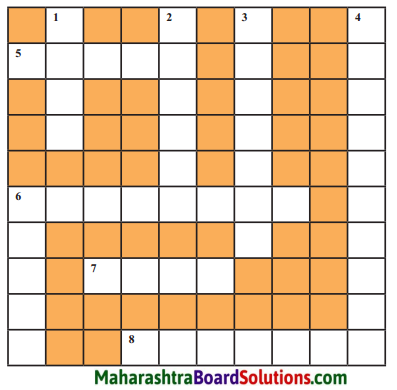
Down:
- A Chinese traveller to India.
- A famous Indo-Greek King had discussions with this Buddha Bhikkhu.
- A poet at the court of Emperor Harshavardhan, who also wrote his biography.
- Chandragupta II conquered this state in neighbouring Gujarat.
Across: - The most famous Indo-Greek King
- A Pali word that means question.
- Kanishka was the first Emperor to make this from gold.
- An ancient Indian University where the Chinese traveller Yuan Chwang stayed for two years.
Answer:
Down:
- Fa-Hien
- Milind
- Banabhatta
- Malwa
Across: - Panhai
- Menander
- Coin
- Nalanda
Activity:
Obtain more information about the rulers of the period following the Maurya period in India. Enact the role of a ruler of your choice.
![]()
Class 6 History Chapter 8 States after the Maurya Empire Additional Important Questions and Answers
Complete the sentence by choosing the correct option:
Question 1.
The last Mauryan emperor was _______.
(a) Chandragupta
(b) Brihadratha
(c) Ashoka
Answer:
(b) Brihadratha
Question 2.
The Indo-Greek kings had a tradition of putting the ,______ of the king on one side and that of a deity on the other side of the coin
(a) map
(b) picture
(c) family
Answer:
(b) picture
Question 3.
One of the famous Indo-Greek kings was _________.
(a) Menander
(b) Alexander
(c) Nagasena
Answer:
(a) Menander
Question 4.
Menander disussed Buddhist philosophy with the Buddhist bhikkhu _____.
(a) Fa-Hein
(b) Ashoka
(c) Nagasena
Answer:
(c) Nagasena
Question 5.
Menander is also referred to as ________.
(a) Pushyamitra
(b) Panha
(c) Milinda
Answer:
(c) Milinda
Question 6.
The Kushanas established their________ in the northwestern region and in Kashmir in the first century CE.
(a) family
(b) friends
(c) rule
Answer:
(c) rule
![]()
Question 7.
The Kushan kings were the first to start minting ________ coins in India.
(a) iron
(b) copper
(c) gold
Answer:
(c) gold
Question 8.
The ________ kings started the custom of putting the images of Gautam Buddha and different Indian deities on the coins.
(a) Kushana
(b) Gupta
(c) Vardhaman
Answer:
(a) Kushana
Question 9.
Gold and copper coins minted by Kanishka have been found in ________ India.
(a) south
(b) north
(c) east
Answer:
(b) north
Question 10.
The ________ Buddhist council was held in Kashmir during Kanishka’s reign.
(a) fourth
(b) fifth
(c) sixth
Answer:
(a) fourth
Question 11.
Kanishka established the city of _______ in Kashmir.
(a) Saurashtra
(b) Malwa
(c) Kanishkapur
Answer:
(c) Kanishkapur
Question 12.
The well-known poet _________ lived during the reign of Kanishka.
(a) Ashvaghosh
(b) Charaka
(c) Nagasena
Answer:
(a) Ashvaghosh
Question 13.
The famous vaidya ______ was also in Kanishka’s court.
(a) Chandra
(b) Charaka
(c) Shrigupta
Answer:
(b) Charaka
![]()
Question 14.
The Guptas remained in power for nearly _____ centuries.
(a) one
(c) two
(c) three
Answer:
(c) three
Question 15.
_____ was the founder of the Gupta dynasty.
(a) Shrigupta
(b) Samudragupta
(c) Brihadratha
Answer:
(a) Shrigupta
Question 16.
Samudragupta and Chandragupta II were the notable kings of the ________ dynasty.
(a) Maurya
(b) Gupta
(c) Nanda
Answer:
(b) Gupta
Question 17.
A pillar inscription at Prayag describes _________ conquests and victories.
(a) Samudragupta’s
(b) Chandragupta’s
(c) Ashoka’s
Answer:
(a) Samudragupta’s
Question 18.
Samudragupta was an excellent ______ player.
(a) drum
(b) guitar
(c) veena
Answer:
(c) veena
Question 19.
In the Gupta period, the Bauddha bhikkhu Fa-Hien came to ______ from China.
(a) Sri Lanka
(b) India
(c) Nepal
Answer:
(b) India
Question 20.
______ has written an account of his travels in India.
(a) Harshavardhan
(b) Yuan Chwang
(c) Fa-Hien
Answer:
(c) Fa-Hien
Question 21.
Prabhakar Vardhan was the _______ of Thanesar, near Delhi.
(a) general
(b) minister
(c) king
Answer:
(c) king
Question 22.
The Vardhan dynasty was founded by ______.
(a) Prabhakar Vardhan
(b) Harshavardhan
(c) Kamrup
Answer:
(a) Prabhakar Vardhan
![]()
Question 23.
Harshavardhan established friendly relations with the emperor of ________.
(a) Sri Lanka
(b) China
(c) Tamil Nadu
Answer:
(b) China
Question 24.
The capital of Harshavardhan’s Empire was ________.
(a) Kanauj
(b) Kamrup
(c) Nalanda
Answer:
(a) Kanauj
Question 25.
Harshavardhan spent a large portion of his ________ for the welfare of the people.
(a) kingdom
(b) revenue
(c) mines
Answer:
(b) revenue
Question 26.
The court poet ______ wrote Harshacharita a biography of Emperor Harshavardhan.
(a) Fa-Hien
(b) Banabhatta
(c) Nalanda
Answer:
(b) Banabhatta
Question 27.
Harshavardhan had become a follower of ________.
(a) Buddhism
(b) Jainism
(c) Judaism
Answer:
(a) Buddhism
Question 28.
The Buddhist Bhikkhu ________ had come to India from China during the regime of Harshavardhan.
(a) Yuan Chwang
(b) Fa-Hien
(c) Magasthenes
Answer:
(a) Yuan Chwang
![]()
Question 29.
Yuan Chwang stayed at the ________ University for two years.
(a) Mumbai
(b) Oxford
(c) Nalanda
Answer:
(c) Nalanda
Question 30.
Yuan Chwang translated many Buddhist manuscripts into _________.
(a) Hindi
(b) Chinese
(c) Pali
Answer:
(b) Chinese
Question 31.
The state of ______ emerged in the fourth century CE.
(a) Harappa
(b) Mohen-jo-daro
(c) Kamrup
Answer:
(c) Kamrup
Question 32.
The epics Mahabharta and Ramayana use the name Tragjyotish’ for ________.
(a) Kamrup
(b) Magdha
(c) Avanti
Answer:
(a) Kamrup
Question 33.
The capital of Pragjyotish state was _______.
(a) Kashmir
(b) Pragjyotishpur
(c) Manipur
Answer:
(b) Pragjyotishpur
Question 34.
During the reign of King Bhaskar Varman, Yuan Chwang had visited _________.
(a) Kamrup
(b) Nalanda
(c) Manipur
Answer:
(a) Kamrup
![]()
Match the following:
Question 1.
| Column A | Column B |
| (1) Brihadratha | (a) Vaidya at Kanishka’s court |
| (2) Menander | (b) First to mint gold coins in India |
| (3) Charaka | (c) Last Maurya king |
| (4) Kushana kings | (d) Stayed at Nalanda university |
| (5) Yuan Chwang | (e) Famous Indo-Greek kings |
Answer:
1 – c
2 – e
3 – a
4 – b
5 – d
Answer in one sentence:
Question 1.
Who was the last Mauryan Emperor?
Answer:
The last Mauryan emperor was Brihadratha.
Question 2.
How did Pushyamitra become a king?
Answer:
The Mauryan general Pushyamitra Shunga revolted against Brihadratha, killed him and became the king himself.
Question 3.
Which kings are known as Indo-Greek kings?
Answer:
There were several small kingdoms in the northwest of the Indian subcontinent, ruled by Greek kings also known as Indo-Greek kings.
Question 4.
Which Indo-Greek tradition took root in India?
Answer:
The Indo-Greek had a tradition of putting the picture of the king on one side and that of a deity on the other of the coin. This tradition later took root in India.
Question 5.
Name of famous Indo-Greek king.
Answer:
One of the famous Indo-Greek king was Menander.
Question 6.
What is the content of Milind-Panha?
Answer:
The questions that were discussed between Bhikkhu Nagasena and Milinda is the content of the book ‘Milind-Panha’.
![]()
Question 7.
In which region did the Kushana tribe establish their rule in India?
Answer:
The Kushana tribe established their rule in the northwestern region and in Kashmir in the first century C.E.
Question 8.
Which custom was started by the Kushana kings?
Answer:
The Kushana kings started a custom of putting the images of Gautam Buddha and different Indian deities on the coins.
Question 9.
Where was the fourth Buddhist council held?
Answer:
The fourth Buddhist council was held in Kashmir during Kanishka’s reign.
Question 10.
Which poet and vaidya were well-known during the time of Kanishka?
Answer:
During the time of Kaniska, poet Ashvagosh and vaidya Charaka were well-known.
Question 11.
Who was the founder of the Gupta dynasty?
Answer:
Shrigupta was the founder of the Gupta dynasty.
Question 12.
Name two notable kings of the Gupta Dynasty.
Answer:
Samudragupta and Chandragupta II were the two notable kings of the Gupta Dynasty.
Question 13.
Why did Sri Lanka make treaties of friendship with Samudragupta?
Answer:
Due to Samudragupta’s victories, Sri Lanka came to be recognised everywhere. So Sri Lanka made a treaty of friendship with him.
Question 14.
Which Bhikkhu from China visited India during Chandragupta’s reign?
Answer:
The Buddha Bhikkhu Fa-Hein came to India from China during Chandragupta’s reign.
Question 15.
What do we learn from Fa-Hien’s account of his travels in India?
Answer:
From Fa-Hien’s account of his travels in India we learn about the efficient administration of the Gupta emperors.
Question 16.
Who was the founder of the Vardhan Dynasty?
Answer:
Prabhakar Vardhan was the founder of the . Vardhan Dynasty.
![]()
Question 17.
Where was the capital of Harshavardhan’s Empire?
Answer:
The capital of Harshavardhan’s Empire was Kanauj.
Question 18.
Which Chinese bhikkhu came to India during the reign of Harshavardhan?
Answer:
The Buddhist bhikkhu Yuan Chwang had come to India from China during Harshavardhan’s reign.
Question 19.
Why did Yuan Chwang stay at Nalanda?
Answer:
Yuan Chwang stayed at the Nalanda University for two years to learn and gain more knowledge about the Buddhist manuscripts.
Question 20.
Which state in ancient India is the present city of Guwahati?
Answer:
The ancient state of Pragjyotish is the present city of Guwahati in Assam.
Question 21
During whose reign did Yuan Chwang visit ‘Kamrup’?
Answer:
During the reign of king Bhaskar Varman, Yuan Chwang visited ‘Kamrup’.
